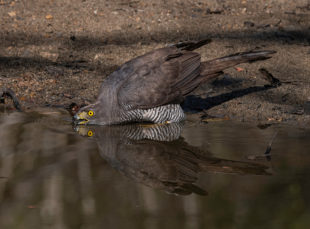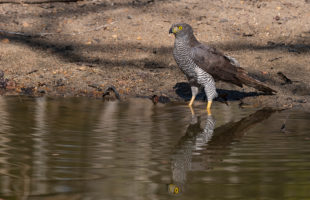The Madagascar Goshawk or Henst’s Goshawk (Accipiter henstii) lives up to its name: it lives exclusively on the red island and cannot be found anywhere else in the world. It can often be seen circling high in the sky during the dry season. Henst’s Goshawk grows to 52 to 62 centimeters with an impressive wingspan of 86 to 100 centimeters. Females are somewhat larger and weigh about one kilogram, almost twice as much as males. Otherwise, the two sexes hardly differ externally. Their characteristic call is a succession of loud, fast, shrill “Peee”.
The Henst’s Goshawk is best found in the coastal regions of eastern, northern, and western Madagascar. More frequent findings are known from the rainforests of Masoala, Ranomafana, Bemanevika, and the dry forest of Kirindy. It was long assumed that the Henst’s Goshawk was entirely absent in the south. However, observations in 2014 suggest that the large raptor occurs in some areas along the Fiherenana River not far from Toliara (Tuléar). Pristine, dense forests are the preferred habitat for Henst’s Goshawk. However, in the reserve of Kirindy, it also lives in a managed dry forest.

Henst’s Goshawks are best observed on their so-called perches. These are free-standing, broken tree trunks or other high vantage points from which the bird of prey probes the surroundings for prey. If an overconfident mouse lemur or an incautious cuckoo is spotted, Henst’s Goshawk strikes. In a rapid dive, it grabs the prey with its powerful, sharp claws. Then the Henst’s Goshawk returns to its perch with its prey. Smaller birds are sometimes also seized from the air in wild chases. Thereby the Henst’s Goshawk manages to hunt extremely skillfully between densely standing trees.
With another prey, the goshawk does not make itself very popular. Malagasy farmers – like everywhere else in the world – do not like it at all when a large bird of prey strikes their chickens and guinea fowls. In fact, however, Henst’s Goshawk is not as big a chicken thief as you may think. It does not like to hunt at all in villages, which offer little visual cover. Its preferred food consists of Blue Couas, Red-breasted Couas, and Madagascan Wood Rails. Lemurs even make up about one-third of the diet: Especially woolly lemurs, as well as brown lemurs, are frequent victims of the agile hunter.
The breeding season of the Madagascar Goshawk is in the late dry season. The nests are relatively large and consist of twigs padded with leaves. They are located in branch forks high up in the treetops, up to 22 meters above the ground. The nest is guarded by the two Henst’s goshawks with Argus’s eyes. Anyone who comes too close to the nest uninvited must expect merciless attacks.

Each female lays two, rarely three eggs between September and November. For a little over a month, the female then broods while the male brings her food. Newly hatched Madagascar hawks still wear a white down coat. Few of them make it to adulthood. Harriers and other birds of prey take the young hawks directly from the nest. The exposed location of the nest in the treetops also makes them more vulnerable to severe weather. The Henst’s Goshawks that make it to adulthood find a mate and soon provide for the next generation of raptors. To their mate, Henst’s Goshawks are faithful for life.
The future prospects for the lizard goshawk could be better: the population currently measures only 1000 to 3000 birds. On the IUCN red list, the Madagascar goshawk is considered endangered. Numbers are declining. Slash and burn and logging are leading to a steady habitat reduction. However, Henst’s Goshawk occurs in several protected areas where it is left alone. With a little luck, Henst’s Goshawks will continue to fly their circles over the tropical island of Madagascar in the coming years.
- Calls and songs of Henst’s Goshawks on xeno-canto.org
- Pictures and videos in The Internet Bird Collection
 MADAMAGAZINE Your Magazine about Madagascar
MADAMAGAZINE Your Magazine about Madagascar




